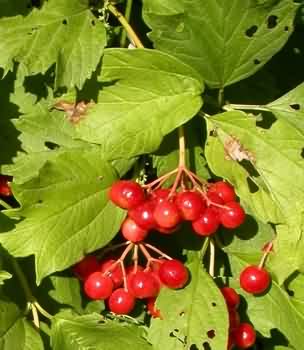Relatives
Viburnum opulus L. - Guelder-rose ordinary.
Taxonomic position.
Family: Viburnaceae Rafin.; genus: Viburnum L.Morphology and biology.
A perennial plant: a bush from 1,5 up to 4 m in height or a low tree. A bark has greish-brown color, with slits. Young runaways are naked. Leaves of the various forms, from ovare up toround, 5-10 cm in the width and in the length, three-, rare - five -lobed. The top leaves on blossoming branches sometimes can be integral or with feebly marked lateral lobes, the form of this leaves is elliptic. The basis of leaves is round truncated or cuneiformis, less often - superficially heart-shaped. The average blade of leaf is quadrangular, in the top part with large pointeddenticles. Lateral lobes from their lateral parts are aspecthave denticles, rare - entire. The topside of leaves are dark green, naked, bottom - glaucous, sometimes more or less pubescent by soft velvetyhairs. Stalks in 4-5 times are shorter than a plate; have at the basis two threadlike stipules, which grow together with stalk. And there are two disk glanduls above. Inflorescences are friable umbellate panicles, 5-10 cm in width, located on tops of young branches, carrying 2 pairs of leaves. Panicles represent a leg, 2,5-5 cm in length, from which 6-8 basic beams depart, ramified in the top part. Bracts are narrow, naked, fall down after flowering. Regional fruitless flowers - on thin pedicels of 1-2 cm in length, white, flat, up to 2,5 cm in diameter, with five unequal blades, bisexual. Internal flowers are sessile or on very short pedicels, white or pinkish-white, about 5 mm in diameter, with wide blunt lobes. Stamens are longer than a nimbus in 1,5 times. Anthers are yellow. Gynaecium has cylindrical form. Fruits are spherical or wide-elliptic, 8-10 mm in length, bright red colored. Stone is wide - heart-shaped orround, 7-9 mm in length, pointed on a top, with a rough surface. Blossoms in May - July, fructifies in August - September.Distribution.
The general distribution: Scandinavia - up to 67 degrees of northern altitude, Middle and Atlantic Europe, the Mediterranea, Balkan - Asia Minor, Armenian - Kurdish areas. In territory of the former USSR: the European part - a southern part of Karelian - Lappish and Dvinsk - Pechora areas, the central areas of the European part of the former USSR, Black Sea Coast, Crimea, the Bottom Don; Caucasus - Ciscaucasia and Transcaucasia (except for northern part), Dagestan; Western Siberia - south of Obsky, Upper-Tobolsk, Irtysh, Altay, Angara - Sajansk areas; Central Asia - separate areas in north of Tian - Shan, in Zailijsky Ala Tau, seldom.Ecology.
In underbrushs and on marges of the damp deciduous and mixed woods, in woody - bushes thrickets, especially - on coast of the rivers, lakes, bogs, and also on ravines and gorges. In mountains it grows on the average and the bottom mountain belt.Use and economic value.
The ornamental plant, it is raised in gardens and parks. Decorative forms are with spherical inflorescences, with golden fruits and variegated leaves. Fruits are used for food after being frozen up, which promotes removal of bitterness. Medicinal plant: the bark is used in official medicine, and flowers and fruits are used in national medicine. The bark contains glukozides and different acids, and also tannin and saccharose. In seeds contains about 20 % of fat oil. Wood is used as firewood and for making of wooden hand-made articles.References:
Areas of trees and bushes of the USSR, 1986. Vol. 3. Sokolov S.J., Svjazeva, O.A. (ed.). - Leningrad: Nauka. P. 134. (in Russian).Cherepanov, S.K. 1995. Plantae Vasculares Rossicae et Civitatum Collimitanearum (in limicis USSR olim). St-Petersburg, "Mir I Semia", 990 p. (in Russian).
Flora USSR, 1948. Vol. XIII, Shishkin B.K., Bobrov E.G. (ed.) - M.-L.: Publishing House of Acad. Science, p. 391. (in Russian).
Popov M.G. 1939. Flora of the Middle Siberia. - M.-L.: Publishing House of Acad. Science, p. 690. (in Russian).
Popov M.G. 1929. Researches of applied botany. Vol. XXI, part 1, p. 169. (in Russian).
Tsvelev, N.N. 2000. Manual of the vascular plants of Russia (Leningrad, Pskov and Novgorod district). St.Petersburg, Publishing House of SPHFA, 781 p. (in Russian).


